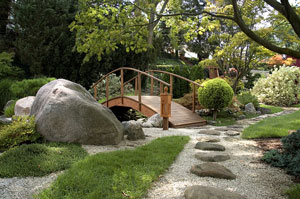
A natural energy and a place to commune with nature — welcome to the beautiful world of soul gardens
Have you ever wondered why so many people enjoy taking walks on the beach, picnicking in the park, camping in the great outdoors, tramping in the bush and climbing in the mountains? These places have a natural energy that resonates with our own, raising our spirits and making us feel more alive. I believe we can bring some of the qualities of these natural environments into our own gardens, providing us with our own personal retreats: places to relax and unwind, to recharge our batteries, safe havens from which to forget the troubles of the world. This is what I call a Garden for the Soul.
For as long as people have roamed the earth, they have found places to commune with nature, often places of outstanding natural beauty. Ancient man worshipped at such sites and, over time, built sanctuaries and temples close by. Man then started building his own version of paradise in the form of gardens. These gardens are all of a contemplative and restorative nature. They are all Gardens for the Soul.
A number of the same elements appear in these gardens. These include water, the archetypal mount, the sacred tree, the island, the meadow, the threshold, enclosure, the cave and paths. These elements stir up strong emotions in us all.
New Zealand is an island nation surrounded by water. We all identify with water in the natural environment in one way or another. Bringing water into the garden may be as simple as introducing a basin of fresh water, it may be an individually designed water feature, or it may be a large pond.
Mountains are a part of New Zealand’s natural landscape and therefore a part of the New Zealand psyche, often inducing strong emotional responses. If a mountain is not visible from the garden, it may be represented by a large rock, a tower or a sculpture.
Individuals have a preference to trees found in the environments in which they were raised, so should include at least one of these in their Gardens for the Soul.
New Zealanders, living on an island, see themselves living in physical isolation, somewhat removed from the troubles of the world. An island may be represented by a large tree in the middle of a lawn, a platform in the middle of a forest, a picnic blanket in the middle of a field, or a rock in the middle of a field of gravel.
The savannah, an open meadow dotted with trees, is the landscape in which we inherently feel most comfortable, as this was the natural landscape of our ancestors. The most common form of the meadow found in gardens is the lawn, but meadows may also be represented by a sunny field of wildflowers, or by a single species planted in a shady dell.
A threshold allows us time to catch our breath before moving on. Thresholds may be represented in the garden by doors, gates, archways, flights of steps, terraces and balconies. Thresholds should offer a clear invitation to enter.
An enclosed space brings us a feeling of security and contentment from which to survey the rest of the world. Enclosures in the garden may be formed by hedges, walls, fences, screens, borders or buildings.
The cave should be a protected place from which to view the garden. It may be represented in the landscape by an arbour, a gazebo, a pergola, a porch or simply by a seat in a secluded corner.
Paths should consist of a departure point (a threshold), an event or events along the way, and a destination point. An event may be a flower or a plant, a statue or a sculpture, a distant view, or a water feature. It may be a personal memento from the past, a reminder of foreign fields or of a lost love. A destination point must have a sense of arrival. It is a place for contemplation.
A Garden for the Soul can be expected to contain a number of these elements. Not all of the elements, however, need to be in such gardens: some will be more important to certain people than others. Individuals must determine which of the elements they identify with in order to create their own Garden for the Soul.
Robyn Laurenson is an Accredited Member (Landscape Design) of Landscaping New Zealand. She is also principal designer of Laurenson Landscape Design. Robyn received the Premier Research Recognition Award at the 2008 Landscaping New Zealand conference for her work on “Searching for Soul in New Zealand Gardens”.
www.soulgardens.co.nz




